After the revival of the Ring in 1877, Wagner himself said “Next year we’ll do things differently”. To him, what mattered was the drama not the packaging. Even arch conservative Houston Chamberlain saw merit in Appia’s ideas but Cosima could not be swayed from her narrow concept of what Wagner had to be.
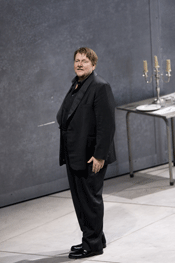 Ben Heppner as Tristan
Ben Heppner as Tristan
The sets for this new Royal Opera House production directly reference Appia, even to the detail of tall arched windows in the background. Throughout the opera, Wagner contrasts night and day..Yet central to this opera is the idea of illusion and delusion . The colour scheme starts with clean black and white contrasts but nothing in this opera is quite as black and white as it seems. Thus the gradual predominance of myriad shades of grey which adapt to changes in light and shadow. The greys are elegant, like silver, silk, suede, marble. The luxury of King Marke’s court is evoked by elegant, minimalist allusion. .
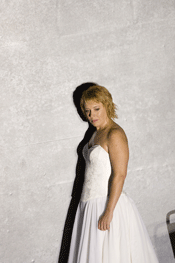 Nina Stemme as Isolde
Nina Stemme as Isolde
The stage was separated into foreground and background, so the drama is concentrated on the foreground without distraction from the essential drama. *Tristan und Isolde* isn’t about furnishings, it’s about ideas of life, love and death, and how people respond to them. Indeed, it’s clear from the libretto that Tristan and Isolde reject material things. Tristan doesn’t want to inherit the kingdom of Cornwall. Isolde knows from experience what power struggles can mean. She may be a prize of war, but she’s not a shallow trophy wife: Marke doesn’t dare touch her. Thus in this production Nina Stemme walks decisively away from the banquet in the background, removes her stilettos and sits with Brang‰ne (Sophie Koch) on simple folding chairs. What she sits on hardly matters when she’s overwhelmed by a love so intense it can overcome death.
*Tristan und Isolde* is an epic tragedy, so this production connects to ancient traditions. In Greek drama, there’s no set at all: actors move to the side when they’re not doing anything. The concept of elaborate staging is relatively recent. Because most people have been brought up on TV and movies, it’s easy to become attuned to the idea that visual images have to be literal so you don’t have to think too much about what’s really going on. In art theatre the opposite holds. It’s the drama that counts, however it’s realized.
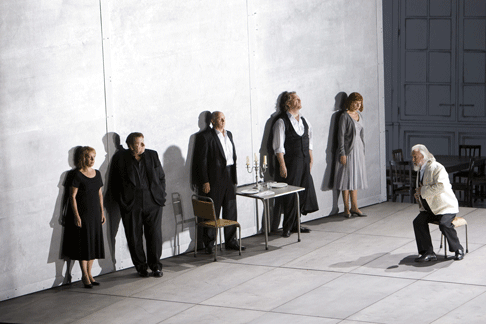 From Left to Right: Nina Stemme as Isolde, Ben Heppner as Tristan, Richard Berkeley-Steele as Melot, Michael Volle as Kurwenal, Sophie Koch as Brag‰ne and John Tomlinson as King Marke
From Left to Right: Nina Stemme as Isolde, Ben Heppner as Tristan, Richard Berkeley-Steele as Melot, Michael Volle as Kurwenal, Sophie Koch as Brag‰ne and John Tomlinson as King Marke
Although Nina Stemme has sung Isolde many times, this may well be one of the defining performances of her career. She moves as if Isolde lives within her: this is method acting at its best. When she sings, her voice rises with utter conviction, so attuned is she to what this Isolde represents. Throughout, her singing and acting were so attuned that it shows how involved sahe was in this production. Like actors, singers need to know how their part fits in with the whole. From the evidence of Stemme’s performance, she’s definitely on message.
Ben Heppner, too, was convincing. Tristan’s heroism was like emotional chain malil, a displacement activity for suppressing his inner demons. So Heppner’s Tristan was a vulnerable, sensitive personality, all the more sympathetic for that than if he were a cocky but shallow young blade. Thus the tenderness between Tristan and Isolde in this production is genuinely moving, and a very important part of the concept. In a world full of treachery and danger, their love is the one thing they can count on. When Stemme and Heppner embrace, there’s real tenderness, all the more intimate because they’re surrounded by vast open space.
So strong are the dramatic dynamic in Loy’s production that Tristan and Isolde aren’’t the only ones experiencing new emotions. I had wondered why a singer of Michael Volle’s stature would be singing Kurnewal, but he turns it into a very major part. Just as the theme of night and day infuses the opera, Tristan and Kurnewal are like night and day. Volle’s Kurnewal is such a forceful character he might match Isolde for mettle. This adds a deeper element to their relationships. Volle’s Kurnewal is so strong that like Isolde he’s fiercely protective although he doesn’t really relate to Tristan’s complexities. When at last it dawns on him what Tristan is about, Volle’s Kurnewal undergoes a kind of transfiguration., lower key than the principals, but a chnge nonetheless. Volle sang with such authority that he almost gave John Tomlinson’s King Marke competition. Tomlinson’s voice is showing signs of strain, but as Marke. that gives his portrayal an edge of world weariness, which is perfectly apt.
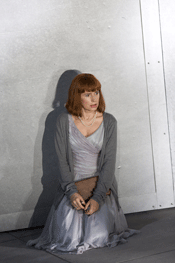 Sophie Koch as Brag‰ne
Sophie Koch as Brag‰ne
Sophie Koch’s Brang‰ne isn’t the elderly nag some productions would have but a lively young woman. We don’t know what Br‰ngane will go onto do, but Koch’s energy might indicate that, like Kurnewal, she will go on with life with greater understanding. Richard Berkeley-Steele sang Melot with deceptive smoothness. He wields his knife with lethal swiftness.
Good operas operate on many different levels, revealing their depths only with time and experience. So too, this production, which hints at a lot more than meets the eye .Eventually, the men in the banquet are shown falling asleep, as if drunk, just as Tristan and Isolde were intoxicated. Slowly, as if in freeze frame, the men rise up and stab each other, as Melot had stabbed Tristan. This happens in the background, and doesn’t impinge on the main action, so is glimpsed rather than made explicit. Perhaps this extends the drama into the outer world, where power games and treachery abound, and it makes the men of Marke’s court more human than the ciphers they sometimes are. Visual images, by their very nature are elusive, so if we can’t grasp them straight away, it’s no demerit: they fall into place in time.
This was uncommonly musically literate production. With all trappings removed the emphasis is on the music, from which all the stage action evolves..Gestures, footsteps, angles take their cue from the music, blocked almost as if choreographed. Stemme walks diagonally from the back to the foreground, her progress sustaining the tension in the music.. All focus is on how the music moves, so the pace unfolds as the music does. Here the music was the “star” just as present as the singers. Apart from a few moments in the First act, easily corrected later, the orchestral playing was of a high standard as is usual at the Royal Opera House. Not every conductor is a Furtw‰ngler, nor should we expect anyone to be, but Antonio Pappano is good and reliable, and gets the best from his musicians.
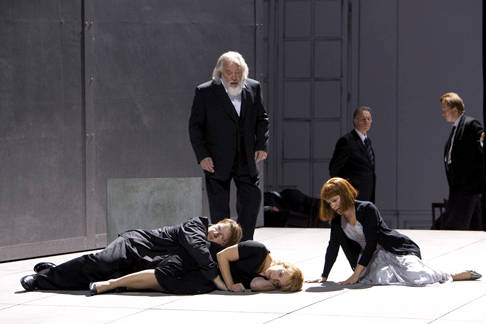 Ben Heppner as Tristan, Nina Stemme as Isolde, John Tomlinson as King Marke and Sophie Koch as Brag‰ne (At the back: Ryland Davies as Shepherd and Dawid Kimberg as Steersman)
Ben Heppner as Tristan, Nina Stemme as Isolde, John Tomlinson as King Marke and Sophie Koch as Brag‰ne (At the back: Ryland Davies as Shepherd and Dawid Kimberg as Steersman)
And the *Liebestod*? Stemme seemed to glow from within,, even when she was singing prone on the floor, in Heppner’s arms. They remain entwined as long as possible. Throughout the opera, different levels of reality have been in play. Stemme goes and sits in the chair where Tristan had sat earlier when he’d confronted his demons, and where Kurnewal came to understand. Throughout this opera, Wagner stresses that all this are mutable. The chair is temporary and it’s frail but what it symbolizes is powerful. Material things mean nothing at all in the face of love so intense that it can overcome death.
The boundaries of life and death no longer exist. Tristan and Isolde are united for eternity on some transfigured plane. Isolde may not have healed the wound made by Melot’s knife, but Tristan’s real wounds went much deeper. His wound was in his soul, and that wound she did heal, through love.
Anne Ozorio
image=http://www.operatoday.com/BC20090924661.gif
image_description=Sophie Koch as Brag‰ne and Nina Stemme as Isolde [Photo by Bill Cooper courtesy of Royal Opera House]
product=yes
product_title=Richard Wagner: Tristan und Isolde
product_by=Nina Stemme (Isolde), soophie Koch (Brang‰ne), Ben Heppner (Tristan), Michael Volle (Kurnewal), John Tomlinson (King marke), Richard Berkeley-Steele (Melot Ryland Davies (shepherd), Dawid Kimberg (Steersman), Ji-min Park (Sailor). Royal Opera House Chorus, Renato Balsadonna (chorus director), Orchestra of the Royal Opera House, Vasko Vassilev (concert master). Antonio Pappano (conductor), Christof Loy (director), Johannes Leiacker (designs), Olaf Winter (Lighting), Marion Tiedtke (dramaturg). Royal Opera House, London. 29th September 2009
product_id=Above: Sophie Koch as Brag‰ne and Nina Stemme as Isolde
All photos by Bill Cooper courtesy of Royal Opera House